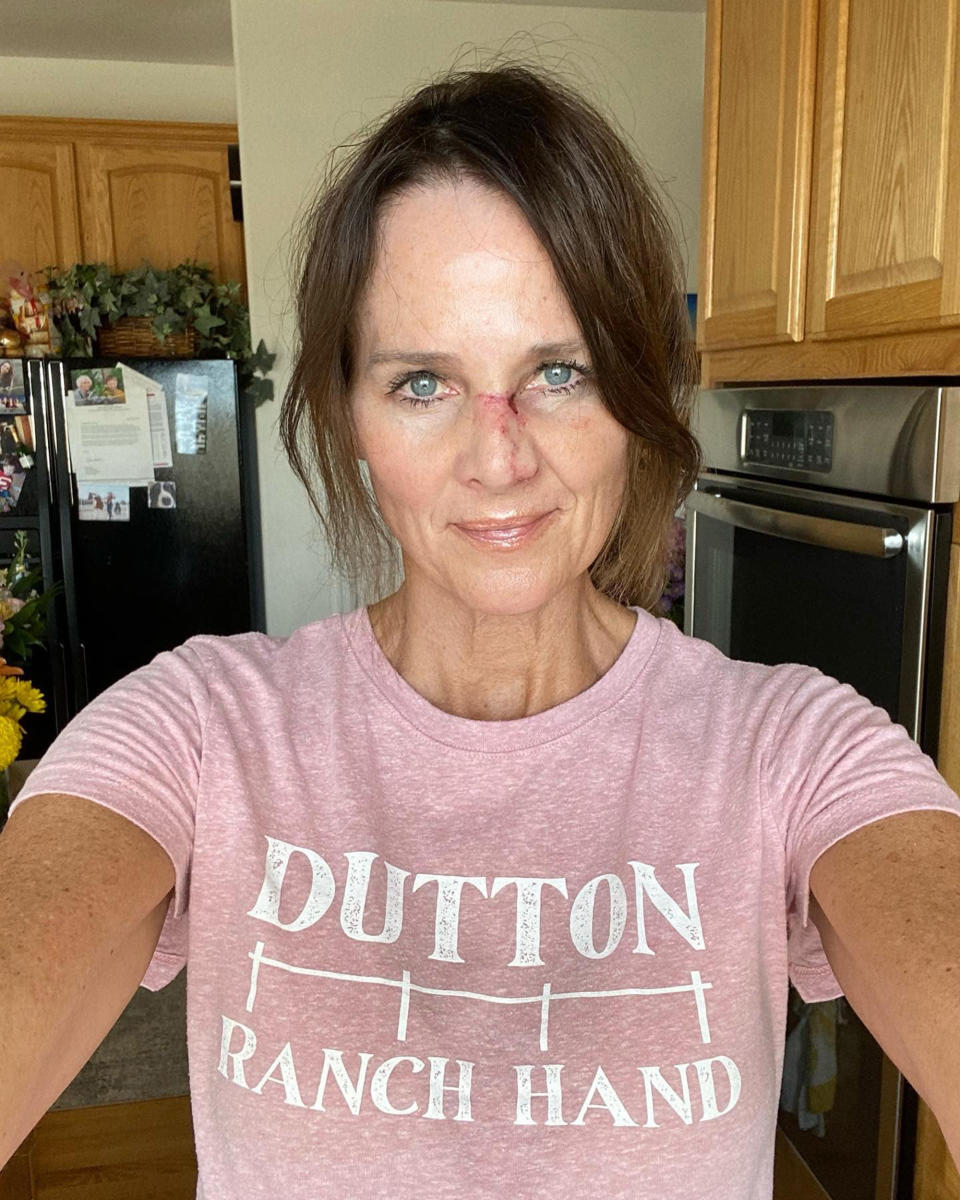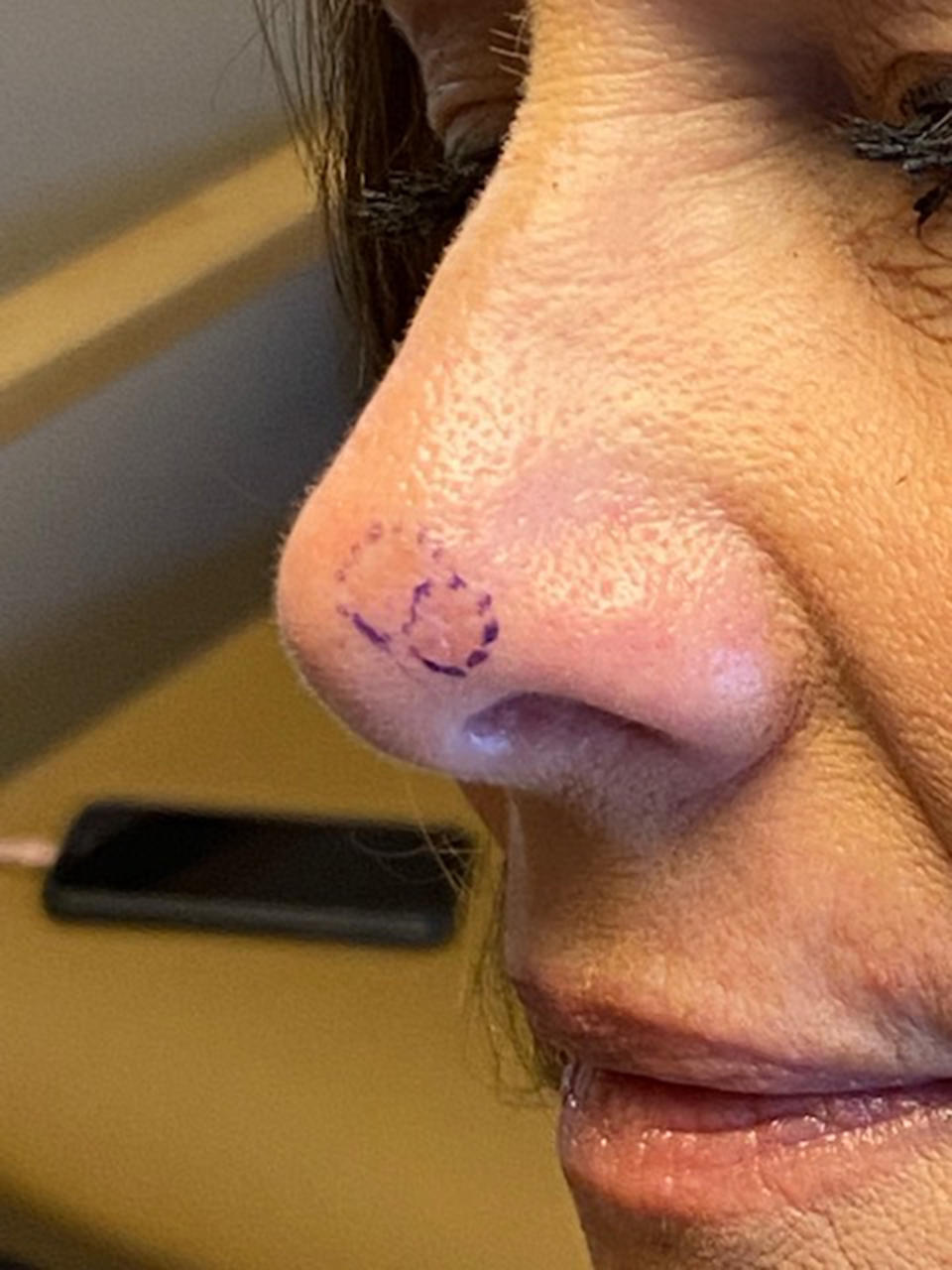Skin Cancer Symptoms: Meteorologist Shares Surgery Scar Photos
Kathy Sabine still remembers the moment she found out a harmless-looking spot on her nose was actually skin cancer that would require surgeons to cut into her face.
There was so much at stake: With a job on television, Sabine — the chief meteorologist at 9NEWS, the NBC affiliate in Denver — is in the public spotlight every day. She wears sunscreen and hats to protect her skin and gets regular checkups from her dermatologist, she said.
“When (my doctor) called back and told me that I had skin cancer, I was shocked. I never thought this would happen to me. I thought I was doing everything right,” Sabine, 57, told TODAY.
“I started crying, I was in disbelief. And then I thought, is this going to be a career ender for me? ... Is this it? I’m going to be done before I’m ready to be done in my 50s.”

Sabine was back on the air this week, a month after undergoing surgery to remove the non-melanoma skin cancer and reconstruct her nose using cartilage from her ear. She’s been open about the ordeal, taking to social media to share frank, striking photos that showed the aftermath of the procedure and the healing process.
Sabine, in turn, heard stories similar to her own.
“So many people shared with me how they were scared and depressed and isolated and hid in their homes when their face looked like mine,” she said.
“I just wanted to get out there and say, ‘Look, you can get back to your life. You can survive this.’ … If I can inspire one person through that journey, because I get all those feelings, I’m so here for it.”
"This spot is bugging me"
Sabine, who grew up in the Lake Tahoe area and has lived in Colorado for 29 years, called herself an “outdoor adventure girl” who rides horses, skis, runs and loves to be outside. She had some sunburns as a child, but has been vigilant about protecting herself from the sun since, she said.
When a spot recently appeared on her nose, Sabine asked about it during her full body skin check earlier this year, but it didn’t raise any concerns at that time.

In May, she was back at her dermatologist to get advice about hair thinning. On the way out the door, she pointed to the freckle again and told the doctor, “This age spot on my nose is just bugging me. What do you think?”
It’s a classic example of the “doorknob phenomenon,” when a patient waits until the doctor has his or her hand on the doorknob to leave the exam room to bring up a crucial piece of information.
This time, a punch biopsy was scheduled.
The result: basal cell carcinoma, a type of skin cancer that tends to grow slowly and is usually not life-threatening, according to the American Academy of Dermatology. But if it’s not removed, it can grow deeper, form a large tumor and reach into the bone beneath, the AAD cautioned. Basal cell carcinoma often develops on the head or neck and may look like a pimple, scar or sore.
Two surgeries in one day
On July 8, Sabine underwent Mohs surgery, a procedure where the surgeon removes skin on the affected area layer by layer until no more cancer cells are found when the tissue is examined under a microscope.
The spot on her nose turned out to be a basal cell-squamous cell carcinoma hybrid, Sabine said. That second type of skin cancer is also not life-threatening and tends to grow slowly, but it can grow deep and form a tumor, the American Academy of Dermatology noted.
Surgeons also found and removed another squamous cell carcinoma on the bridge of her nose between her eyes. A third spot was biopsied but turned out to be benign.
With three holes in her face, Sabine then underwent plastic surgery to reconstruct her nose using cartilage from her ear.

The resulting scars were startling. Sabine didn’t leave home for the first three weeks as they healed.
When she finally did go out, she was struck by how kind people were, she said.

The meteorologist has just recently been cleared to wear makeup and was back on TV for the first time Wednesday, feeling “a bit anxious.” It will take several more months for the scars and swelling on her face to fade.
“But I’m functioning, I’m out in public,” Sabine noted.
“I’m cleared to exercise, cleared to ride my horse. … I’m still going to keep living my best life, and that includes everything outdoors.”

Skin cancer in Colorado
After the ordeal, Sabine is even more vigilant about using sunscreen and now avoids getting any sun on her face. She urged others to get regular skin checks and point out any spots that don’t look or feel right.
Colorado has the nation’s highest per-capita rate of skin cancer, according to the University of Colorado Cancer Center’s Cancer Prevention and Control Program.
Intense sun at high altitude may be a factor for the mountainous state, the Colorado Health Institute noted. That’s because there’s less atmosphere available to absorb ultraviolet radiation at higher altitudes.
Lots of sunny days combined with the state’s natural beauty also mean people flock outdoors and may not be adequately protected from UV rays.
“Skin cancer is a thing in Colorado,” Sabine said. “I just feel grateful to have the opportunity and platform to help get the word out on this.”

